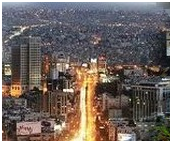
|
|
Amman
|
|
Amman is the capital and largest
city of Jordan. It is the country's political, cultural and commercial centre and
one of the oldest continuously inhabited cities in the world. Located in a hilly
area north-western Jordan, the city was originally built on seven hills, but it
now spans over an area of nineteen hills (each known as a Jabal, Tál, Mount or Mountain) .Read More »
|
|
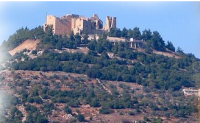
|
|
Ajloun
|
|
The road to ‘Ajloun, located 25 kilometers west of Jerash and 73 kilometers from Amman, winds through fertile green hillsides lined with olive groves. The main attraction in ‘Ajloun is the stronghold of Qala’at al-Rabadh, a fine example of medieval Arab/Islamic military architecture. The castle was built in 1184-1185 CE by the Izzeddin Usama Munqith (The nephew of Salah al-Din Al Ayyoubi - known in the West as Saladin). .Read More »
|
|

|
|
Aqaba
|
|
Aqaba is a coastal town in the far south of Jordan. Aqaba is strategically important. to Jordan as it is the country's only seaport. With its wealth of other attractions, Jordan’s splendid Red Sea resort is often overlooked by modern-day visitors. But apart from being a delightful place for discerning
holidaymakers, this is actually a great base from which to explore various places of interest in southern Jordan. .Read More »
|
|
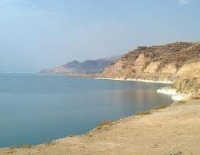
|
|
Dead sea
|
|
The lowest point on the face of the earth.
Without a doubt the world’s most amazing place, the Jordan Rift Valley is a dramatic, beautiful landscape, which at the Dead Sea, is over 400m (1,312 ft.) below sea level, this vast stretch of water receives a number of incoming rivers, including the River Jordan. Once the waters reach the Dead Sea they are land-locked and have nowhere to go, so they evaporate, leaving behind a dense, rich, cocktail of salts and minerals that supply industry, ...Read More »
|
|
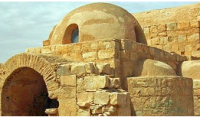
|
|
Desert Castles
|
|
Jordan's desert castles, beautiful examples of both early Islamic art and architecture, stand testament to a fascinating era in the country's rich history. Their fine mosaics, frescoes, stone and stucco carvings and illustrations, inspired by the best in Persian and Graeco-Roman traditions, tell countless stories of the life as it was during the 8th century. Called castles because of their imposing stature, the desert complexes actually served various purposes as caravan stations, agriculture ...Read More »
|
|
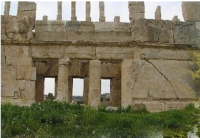
|
|
Iraq Al Amir
|
|
'Iraq al Amir (Arabic:عراق الأمير), located in the Jordan Valley on the hills with high and medium altitude, about 15 km southwest of the town of Wadi Al Seer, the area has many springs, and is famous for its olive trees, in addition to other forest trees. About 0.5 km south of the town is located the so-called Al-Iraq historical site, which was built by a Persian prince in the 3rd century BC. There are many caves in the hills which date back to the Copper Age. .Read More »
|
|
.jpg)
|
|
Jerash
|
|
A close second to Petra on the list of favorite destinations in Jordan is the ancient city of Jerash, which boasts an unbroken chain of human occupation dating back more than 6,500 years. Located in the north of Jordan, 48 kilometers (30 mi) north of the capital Amman towards Syria, Jerash Governorate's geographical features vary from cold mountains to fertile valleys from 250 to 300 meters (820 to 980 ft) above sea level, Jerash lies on a plain surrounded by hilly wooded areas and fertile ...Read More »
|
|
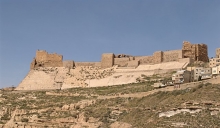
|
|
Kerak
|
|
It is one of the largest crusader castles in the Levant. Whether you approach Kerak from the ancient Kings Highway to the east or from the Dead Sea to the west, the striking silhouette of this fortified town and castle will instantly make you understand why the fates of kings and nations were decided here for millennia.
An ancient Crusader stronghold, Kerak sits 900m above sea level and lies inside the walls of the old city. The city today is home to around 170,000 people and continues to ...Read More »
|
|
.jpg)
|
|
Madaba
|
|
Madaba (Arabic: مادبا, ), is the capital city of Madaba Governorate of Jordan, which has a population of about 60,000. Madaba is the fifth most populous town in Jordan. It is best known for its Byzantine and Umayyad mosaics, especially a large Byzantine-era mosaic map of The Holy Land. Madaba is located 30 kilometers south-west of the capital Amman. .Read More »
|
|
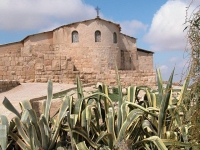
|
|
Mount Nebo
|
|
Mount Nebo (Arabic: جبل نيبو ) is an elevated ridge that is approximately 817 meters (2680 feet) above sea level. The view from the summit provides a panorama of the Holy Land and, to the north, a more limited one of the valley of the River Jordan. The West Bank city of Jericho is usually visible from the summit, as is Jerusalem on a very clear day, according to ancient tradition; this is the mountain from which Moses saw the Promised Land before he died.
Because of its connection to Moses, ...Read More »
|
|
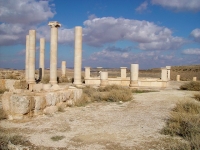
|
|
Mukawir
|
|
The execution site of John the Baptist.This dramatic hilltop is the traditional site of the execution of John the Baptist (pbuh). It lies less than 20 km southwest of Madaba at the King's Highway on a stark promontory (720 m), overlooking the Dead Sea and protected on three sides by deep ravines, A fortress was first built here by the Hasmonean ruler Alexander Jannaeus (103-76 BC) to defend Perea against the expansionist Nabataeans. His widow Alexandra, confident of the site's inviolability, ...Read More »
|
|
.jpg)
|
|
Nature reserves
|
|
A part of Jordan's heritage. Over 40 years ago, while roaming Jordan’s familiar mountains, plains and valleys in search of game, hunters began noticing a serious decline in wildlife, along with the deterioration that had slowly crept into the heart of some of the country’s most beautiful natural sites. In place of the vibrant wildlife they had become accustomed to, they came across an almost tangible feeling of scarcity – a shadow of a past still fresh in their minds. With these memories in ...Read More »
|
|
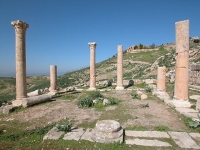
|
|
Pella
|
|
Pella (known in Arabic as Tabaqat Fahl (طبقة فحل)) is a village and the site of ancient ruins in northwestern Jordan. 78 km north of Amman, Pella is located in the Jordan valley some 130 km north of Amman, and the site has been continuously occupied since Neolithic times. First mentioned in the 19th century BC in Egyptian inscriptions, its name was Hellenised to Pella, perhaps to honor Alexander the Great's birthplace. The Roman city, of which some spectacular ruins remain, supplanted the ...Read More »
|
|
.jpg)
|
|
Petra
|
|
It has to be seen to be believed, one of the greatest wonders ever wrought by Nature and Man.
The giant red mountains and vast mausoleums of a departed race have nothing in common with modern civilization, and ask nothing of it except to be appreciated at their true value,
Although much has been written about Petra, nothing really prepares you for this amazing place.
.Read More »
|
|
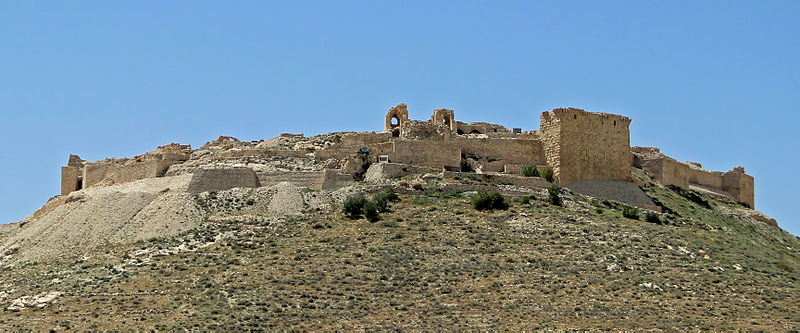
|
|
Shobak Castle
|
|
The castle was built in 1115 by Baldwin I of Jerusalem during his expedition to the area where he captured Aqaba on the Red Sea in 1116. Originally called 'Krak de Montreal' or 'Mons Regalis', it was named in honor of the king's own contribution to its construction (Mont Royal). It was strategically located on a hill on the plain of Edom, along the pilgrimage and caravan routes from Syria to Arabia. This allowed Baldwin to control the commerce of the area, as pilgrims and merchants needed ...Read More »
|
|
.jpg)
|
|
The Baptism site
|
|
The Baptism site.The overwhelming biblical, archaeological, and historical evidence has led many religious leaders throughout the world to recognize this site as the authentic site of Jesus' baptism. Bethany beyond the Jordan" is situated a few hundred meters from the Jordan River. Excavations have uncovered 1st century AD settlement with plastered pools and water systems that were used almost certainly for baptism, a 5th - 6th century AD late Byzantine settlement with churches, a monastery and ...Read More »
|
|
.jpg)
|
|
Um Rassas
|
|
Umm al-Rasas (also spelled Umm ar-Rasas and Um er-Rasas) is an important archaeological site that was declared a World Heritage Site in 2004. Its structures date from the 3rd to 9th centuries and most have not yet been excavated. The site is especially known for its magnificent Byzantine mosaics, which have been uncovered in two churches dating from the 6th and 8th centuries. .Read More »
|
|
.jpg)
|
|
Umm Qais
|
|
Umm Qais (Arabic: أم قيس, also transliterated as Umm Qays) is a town situated in the extreme north-west of the country, where the borders of Jordan, Israel and Syria meet, perched on a hilltop (378 meters above sea level), overlooking the sea of Tiberias, the Golan heights and the Yarmuk gorge. It is located on the site of the ruined Hellenistic-Roman city of Gadara. (The town was also sometimes called Antiochia or Antiochia Semiramis and Seleucia.) The ancient name, Gadara, seems Semitic and ...Read More »
|
|
.jpg)
|
|
Wadi Rum
|
|
Wadi Rum (Arabic: وادي رم) also known as The Valley of the Moon (Arabic: وادي القمر) is a valley cut into the sandstone and granite rock in south Jordan at 60 km (37 mi) to the east of Aqaba. It is the largest wadi in Jordan. The name Rum most likely comes from an Aramaic root meaning 'high' or 'elevated'. To reflect its proper Arabic pronunciation, archaeologists transcribe it as Wadi Ram. The highest elevation in Wadi Rum is Mount Um Dami at more than 1,800 m (5,900 ft) above sea level, ...Read More »
|
|